Singapore: An Analysis of Labor Management Relations
VerifiedAdded on 2019/11/14
|11
|2613
|598
Report
AI Summary
This report provides a comprehensive analysis of Labor Management Relations (LMR) in Singapore, highlighting the unique four-cornered relationship between the government, employers, labor unions, and employees. It delves into the specific roles of each key player, including the Singapore National Employers Federation (SNEF), the National Trades Union Congress (NTUC), and the government's role in fostering a harmonious and competitive environment. The report explores how Singapore's strong LMR contributes to its economic growth, employee satisfaction, and competitive advantage, particularly during times of global uncertainty. It examines the benefits of unionization, the importance of continuous improvement, and the impact of legislative changes like the Industrial Relations (Amendment) Act 2015. The report concludes by emphasizing the need for continued collaboration among all stakeholders to maintain Singapore's strong labor-management relationship and its global competitiveness.
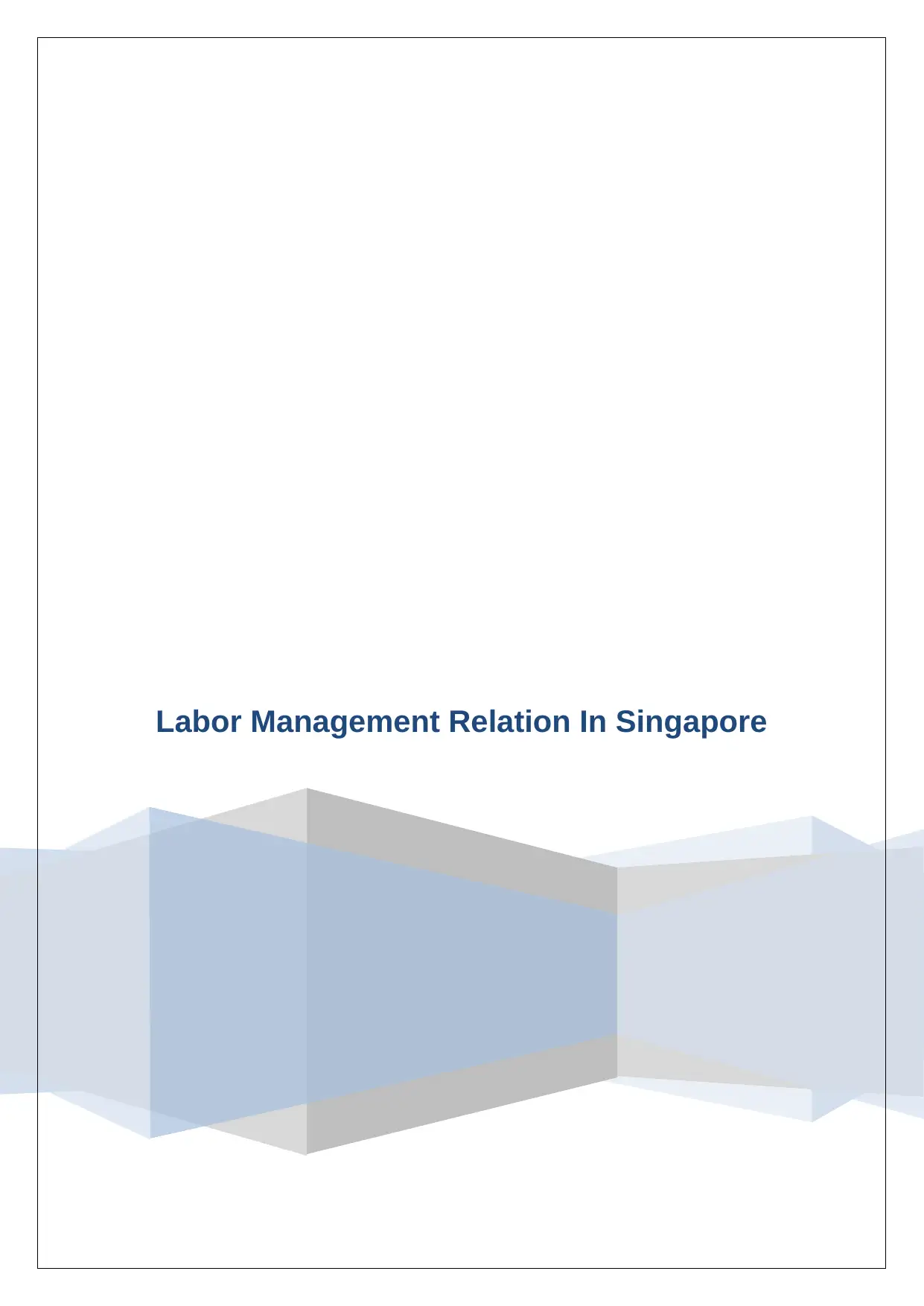
Labor Management Relation In Singapore
Paraphrase This Document
Need a fresh take? Get an instant paraphrase of this document with our AI Paraphraser
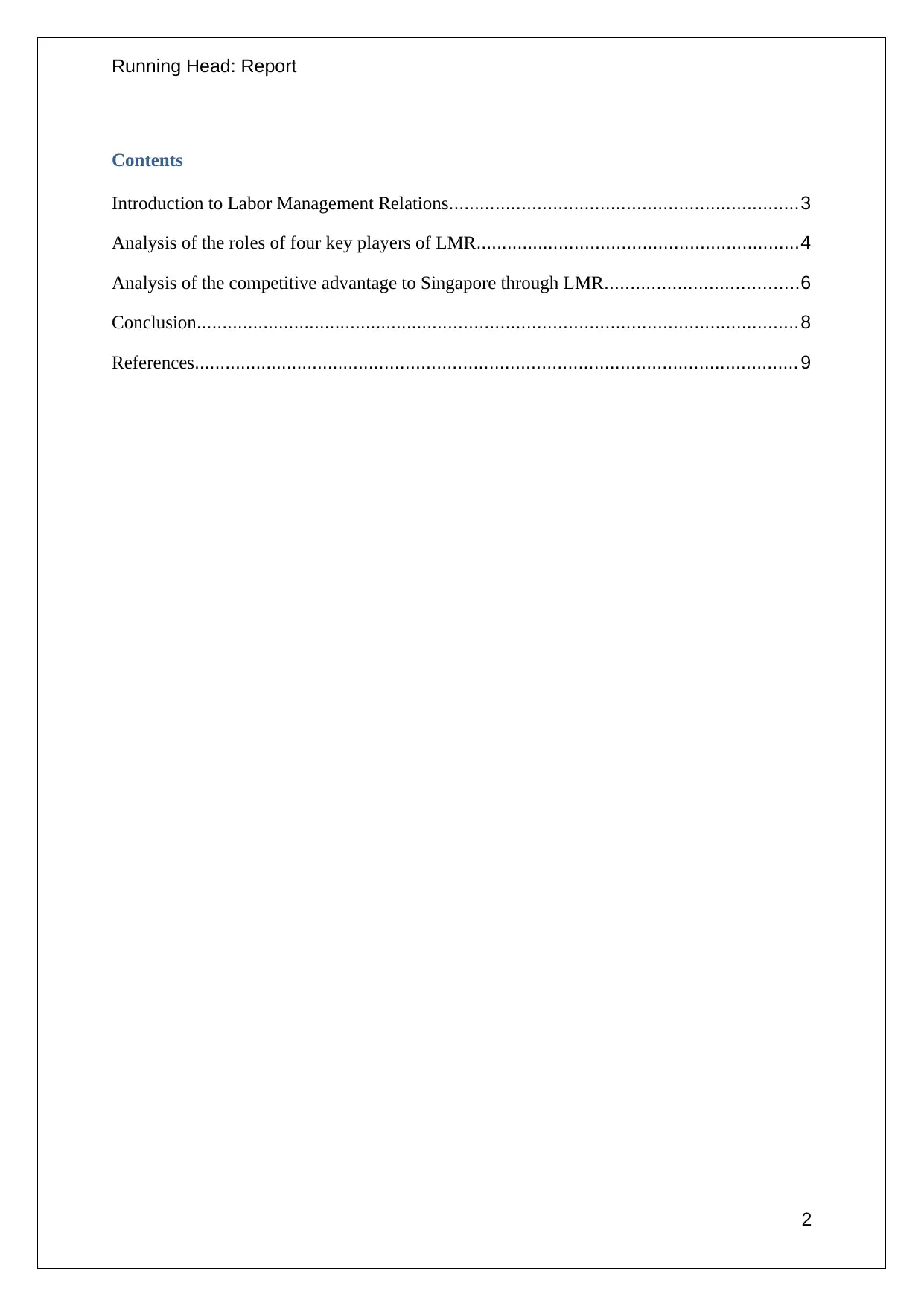
Running Head: Report
Contents
Introduction to Labor Management Relations...................................................................3
Analysis of the roles of four key players of LMR..............................................................4
Analysis of the competitive advantage to Singapore through LMR.....................................6
Conclusion....................................................................................................................8
References.................................................................................................................... 9
2
Contents
Introduction to Labor Management Relations...................................................................3
Analysis of the roles of four key players of LMR..............................................................4
Analysis of the competitive advantage to Singapore through LMR.....................................6
Conclusion....................................................................................................................8
References.................................................................................................................... 9
2

Running Head: Report
Introduction to Labor Management Relations
Of all the functions of the HR managers, Labor Management Relations (LMR) are defined as
one of the most complicated set of relationships to manage. The labor relations in Singapore,
unlike the rest of the world are a four cornered relationship between the government, the
employers, the labor unions and the labourers (NTUC, 2017). The four parties involved need
to coordinate and cooperate with each other to maintain a healthy balance between them. The
success of Singapore and its growth and development can all be contributed to the healthy
balance between these three and a collaborative LMR in the nation. This report has been
written with an intent to better understand and explain the LMR and the various players that
are responsible for the maintenance of the same for Singapore. This report plans to explore
the roles played by the four key elements of the LMR namely; employers, employees, trade
unions and the government. Singapore as a country provides an exceptional example of how
these relations are established and maintained to guide the nation towards development. This
report also plans to explore and conduct a factor analysis of what makes Singapore and their
LMR an interesting and ideal case study. The report further studies about the competitive
advantage that Singapore has as a nation because of their exceptional LMR and a
synchronized approach to the relations of the four players of LMR (Yoon, 2009). The
employees and employers are connected by the professional relationship that they share. The
trade unions are the dependable support that both of them have. Harmonious LMR help in
avoidance of conflict and the difficult situations like strikes, non cooperation, lock outs, etc
can be easily managed and avoided with their help. The LMR also helps in analyzing the
competitiveness, vulnerability and job satisfaction level of the employees in order to take
timely action for their correction of things are amiss. Being ranked the country with the most
co-operative labor-employer relationships by the World Economic Forum, Singapore is a
3
Introduction to Labor Management Relations
Of all the functions of the HR managers, Labor Management Relations (LMR) are defined as
one of the most complicated set of relationships to manage. The labor relations in Singapore,
unlike the rest of the world are a four cornered relationship between the government, the
employers, the labor unions and the labourers (NTUC, 2017). The four parties involved need
to coordinate and cooperate with each other to maintain a healthy balance between them. The
success of Singapore and its growth and development can all be contributed to the healthy
balance between these three and a collaborative LMR in the nation. This report has been
written with an intent to better understand and explain the LMR and the various players that
are responsible for the maintenance of the same for Singapore. This report plans to explore
the roles played by the four key elements of the LMR namely; employers, employees, trade
unions and the government. Singapore as a country provides an exceptional example of how
these relations are established and maintained to guide the nation towards development. This
report also plans to explore and conduct a factor analysis of what makes Singapore and their
LMR an interesting and ideal case study. The report further studies about the competitive
advantage that Singapore has as a nation because of their exceptional LMR and a
synchronized approach to the relations of the four players of LMR (Yoon, 2009). The
employees and employers are connected by the professional relationship that they share. The
trade unions are the dependable support that both of them have. Harmonious LMR help in
avoidance of conflict and the difficult situations like strikes, non cooperation, lock outs, etc
can be easily managed and avoided with their help. The LMR also helps in analyzing the
competitiveness, vulnerability and job satisfaction level of the employees in order to take
timely action for their correction of things are amiss. Being ranked the country with the most
co-operative labor-employer relationships by the World Economic Forum, Singapore is a
3
⊘ This is a preview!⊘
Do you want full access?
Subscribe today to unlock all pages.

Trusted by 1+ million students worldwide

Running Head: Report
competitive nation with every party involved pushing the others to perform their best
(Leggett, Strategic choice and the transformation of Singapore's industrial relations, 2005).
This is the reason of the tremendous economic and social growth of the country and their
people.
Analysis of the roles of four key players of LMR
LMR is defined as a trilateral relationship between the government, the employers and the
laborers. However, if we analyze it closely, there is another player who plays a key role in the
maintenance and management of these relationships. The trade unions who organize the labor
industry are also an important contributor in the LMR and their maintenance. Thus, the four
key players that shoulder the responsibility and help in the maintenance of healthy LMR in
Singapore are 1) Employers 2) Employees 3) Trade unions and 4) Government. Now
understanding the role played by each of these in detail, the employers in Singapore are all a
part of the union for employers named Singapore National Employers Federation (SNEF).
Founded in the year 1980, it has the members count of over 2000 and is an autonomous body
dedicated to help the employers in Singapore make their organizations more productive and
profitable. It also helps the employers in the achievement of work-life balance. This
organization works in sync with the other key players to help the nation in achieving
industrial harmony. SNEF also works towards maintaining and monitoring healthy
competition in the market. The second key player in the LMR are the employees or the
building blocks of the nation (Commission, 2005). Employees are the players forming the
basis of all the unions. The Labor Movement of the National Trades Union Congress (NTUC)
was made an all inclusive movement by the people of Singapore tom unite for the rights of
the employees. There is a need for sustainable development of the country at this time.
4
competitive nation with every party involved pushing the others to perform their best
(Leggett, Strategic choice and the transformation of Singapore's industrial relations, 2005).
This is the reason of the tremendous economic and social growth of the country and their
people.
Analysis of the roles of four key players of LMR
LMR is defined as a trilateral relationship between the government, the employers and the
laborers. However, if we analyze it closely, there is another player who plays a key role in the
maintenance and management of these relationships. The trade unions who organize the labor
industry are also an important contributor in the LMR and their maintenance. Thus, the four
key players that shoulder the responsibility and help in the maintenance of healthy LMR in
Singapore are 1) Employers 2) Employees 3) Trade unions and 4) Government. Now
understanding the role played by each of these in detail, the employers in Singapore are all a
part of the union for employers named Singapore National Employers Federation (SNEF).
Founded in the year 1980, it has the members count of over 2000 and is an autonomous body
dedicated to help the employers in Singapore make their organizations more productive and
profitable. It also helps the employers in the achievement of work-life balance. This
organization works in sync with the other key players to help the nation in achieving
industrial harmony. SNEF also works towards maintaining and monitoring healthy
competition in the market. The second key player in the LMR are the employees or the
building blocks of the nation (Commission, 2005). Employees are the players forming the
basis of all the unions. The Labor Movement of the National Trades Union Congress (NTUC)
was made an all inclusive movement by the people of Singapore tom unite for the rights of
the employees. There is a need for sustainable development of the country at this time.
4
Paraphrase This Document
Need a fresh take? Get an instant paraphrase of this document with our AI Paraphraser

Running Head: Report
Singapore need to train the people and make them skilled and at the same time create jobs for
them. As the people get added to the labor market, job creation needs to go up as well. If this
does not happen, it will lead to structural unemployment for the country resulting in wastage
of resources (Kaur, 2012). The Trade Unions are a generally neglected, but crucial part of the
LMR. Singapore is constantly working towards organizing the labor markets into unions and
unionizing more and more workers has been the objective of the NTUC for very long now.
Having 58 affiliated unions at present, and two affiliated associations which include the
industrial, public, service and omnibus sectors it is the a trade unions working towards the
accomplishment of all the objectives of the Labor Movement in Singapore. They also work
for the protection of the rights of the workers and advocate for their best interests. They help
in collective bargaining and support the employees and their rights. The fourth and the all-
powerful player in the LMR is the government of Singapore. The government and the leading
political party extend the support to all the other key players to maintain a healthy balance
between them. The government leadership and support is required by all in order to actually
contribute to the growth and development of the nation. The Singapore government has
always worked towards providing the employers, employees and the trade unions, an
environment where they can survive and thrive. The Industrial Relations (Amendment) Act
2015 which came into force on 1st April 2015 has made a big difference in the LMR. The act
has allowed the trade unions to represent employees belonging to the non-executive work
functions. This has enabled the trade unions even more and has helped them to represent such
employees collectively, which was earlier not possible. The second amendment made in the
act was to enable the trade unions to represent executive employees on an individual basis,
especially representing them on the issues related to re-employment (Natrss, 2013). The
expansion implemented by the Amendment Act provides executives with an additional and
less costly alternative for resolving re-employment matters, by settling re-employment
5
Singapore need to train the people and make them skilled and at the same time create jobs for
them. As the people get added to the labor market, job creation needs to go up as well. If this
does not happen, it will lead to structural unemployment for the country resulting in wastage
of resources (Kaur, 2012). The Trade Unions are a generally neglected, but crucial part of the
LMR. Singapore is constantly working towards organizing the labor markets into unions and
unionizing more and more workers has been the objective of the NTUC for very long now.
Having 58 affiliated unions at present, and two affiliated associations which include the
industrial, public, service and omnibus sectors it is the a trade unions working towards the
accomplishment of all the objectives of the Labor Movement in Singapore. They also work
for the protection of the rights of the workers and advocate for their best interests. They help
in collective bargaining and support the employees and their rights. The fourth and the all-
powerful player in the LMR is the government of Singapore. The government and the leading
political party extend the support to all the other key players to maintain a healthy balance
between them. The government leadership and support is required by all in order to actually
contribute to the growth and development of the nation. The Singapore government has
always worked towards providing the employers, employees and the trade unions, an
environment where they can survive and thrive. The Industrial Relations (Amendment) Act
2015 which came into force on 1st April 2015 has made a big difference in the LMR. The act
has allowed the trade unions to represent employees belonging to the non-executive work
functions. This has enabled the trade unions even more and has helped them to represent such
employees collectively, which was earlier not possible. The second amendment made in the
act was to enable the trade unions to represent executive employees on an individual basis,
especially representing them on the issues related to re-employment (Natrss, 2013). The
expansion implemented by the Amendment Act provides executives with an additional and
less costly alternative for resolving re-employment matters, by settling re-employment
5
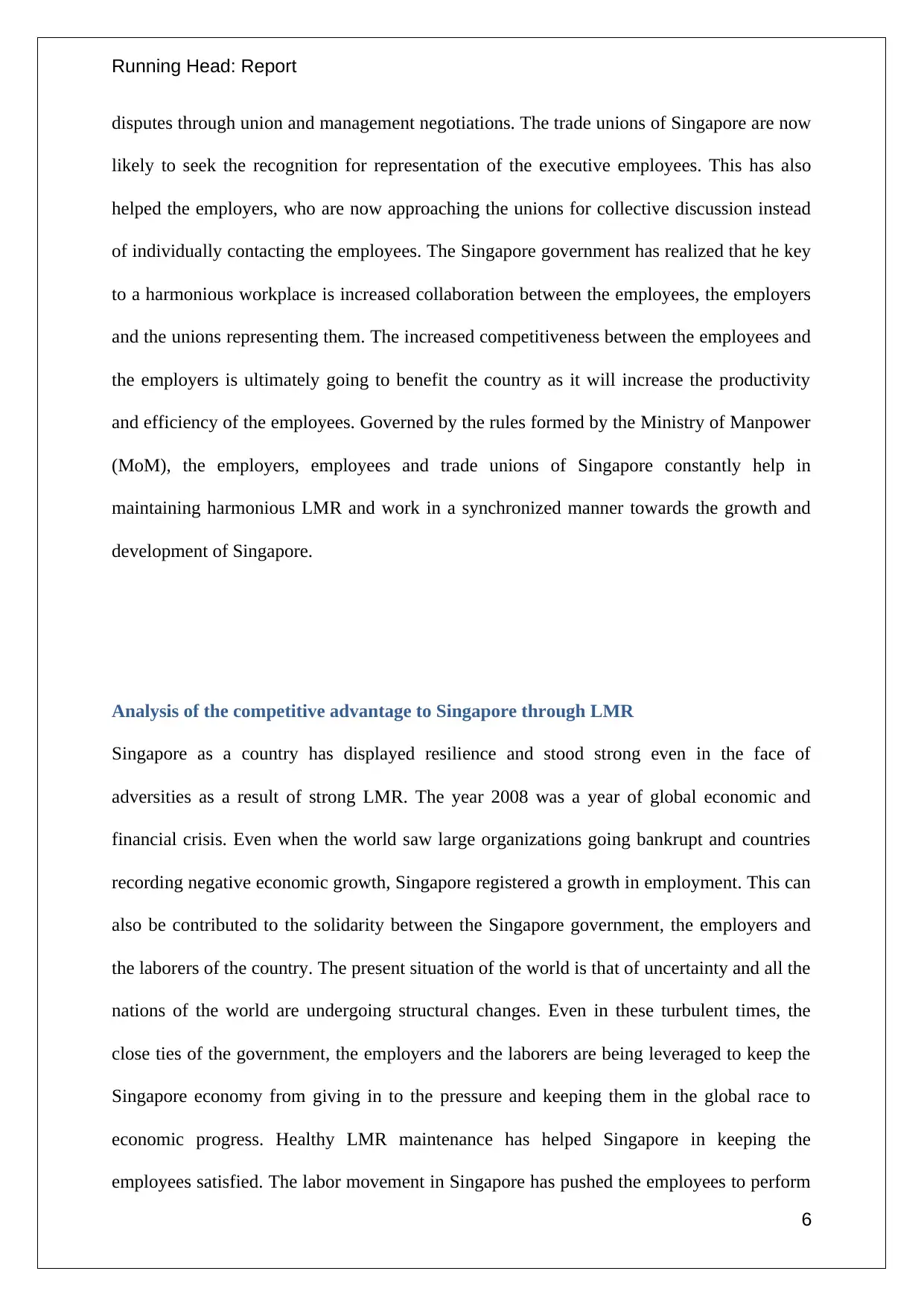
Running Head: Report
disputes through union and management negotiations. The trade unions of Singapore are now
likely to seek the recognition for representation of the executive employees. This has also
helped the employers, who are now approaching the unions for collective discussion instead
of individually contacting the employees. The Singapore government has realized that he key
to a harmonious workplace is increased collaboration between the employees, the employers
and the unions representing them. The increased competitiveness between the employees and
the employers is ultimately going to benefit the country as it will increase the productivity
and efficiency of the employees. Governed by the rules formed by the Ministry of Manpower
(MoM), the employers, employees and trade unions of Singapore constantly help in
maintaining harmonious LMR and work in a synchronized manner towards the growth and
development of Singapore.
Analysis of the competitive advantage to Singapore through LMR
Singapore as a country has displayed resilience and stood strong even in the face of
adversities as a result of strong LMR. The year 2008 was a year of global economic and
financial crisis. Even when the world saw large organizations going bankrupt and countries
recording negative economic growth, Singapore registered a growth in employment. This can
also be contributed to the solidarity between the Singapore government, the employers and
the laborers of the country. The present situation of the world is that of uncertainty and all the
nations of the world are undergoing structural changes. Even in these turbulent times, the
close ties of the government, the employers and the laborers are being leveraged to keep the
Singapore economy from giving in to the pressure and keeping them in the global race to
economic progress. Healthy LMR maintenance has helped Singapore in keeping the
employees satisfied. The labor movement in Singapore has pushed the employees to perform
6
disputes through union and management negotiations. The trade unions of Singapore are now
likely to seek the recognition for representation of the executive employees. This has also
helped the employers, who are now approaching the unions for collective discussion instead
of individually contacting the employees. The Singapore government has realized that he key
to a harmonious workplace is increased collaboration between the employees, the employers
and the unions representing them. The increased competitiveness between the employees and
the employers is ultimately going to benefit the country as it will increase the productivity
and efficiency of the employees. Governed by the rules formed by the Ministry of Manpower
(MoM), the employers, employees and trade unions of Singapore constantly help in
maintaining harmonious LMR and work in a synchronized manner towards the growth and
development of Singapore.
Analysis of the competitive advantage to Singapore through LMR
Singapore as a country has displayed resilience and stood strong even in the face of
adversities as a result of strong LMR. The year 2008 was a year of global economic and
financial crisis. Even when the world saw large organizations going bankrupt and countries
recording negative economic growth, Singapore registered a growth in employment. This can
also be contributed to the solidarity between the Singapore government, the employers and
the laborers of the country. The present situation of the world is that of uncertainty and all the
nations of the world are undergoing structural changes. Even in these turbulent times, the
close ties of the government, the employers and the laborers are being leveraged to keep the
Singapore economy from giving in to the pressure and keeping them in the global race to
economic progress. Healthy LMR maintenance has helped Singapore in keeping the
employees satisfied. The labor movement in Singapore has pushed the employees to perform
6
⊘ This is a preview!⊘
Do you want full access?
Subscribe today to unlock all pages.

Trusted by 1+ million students worldwide
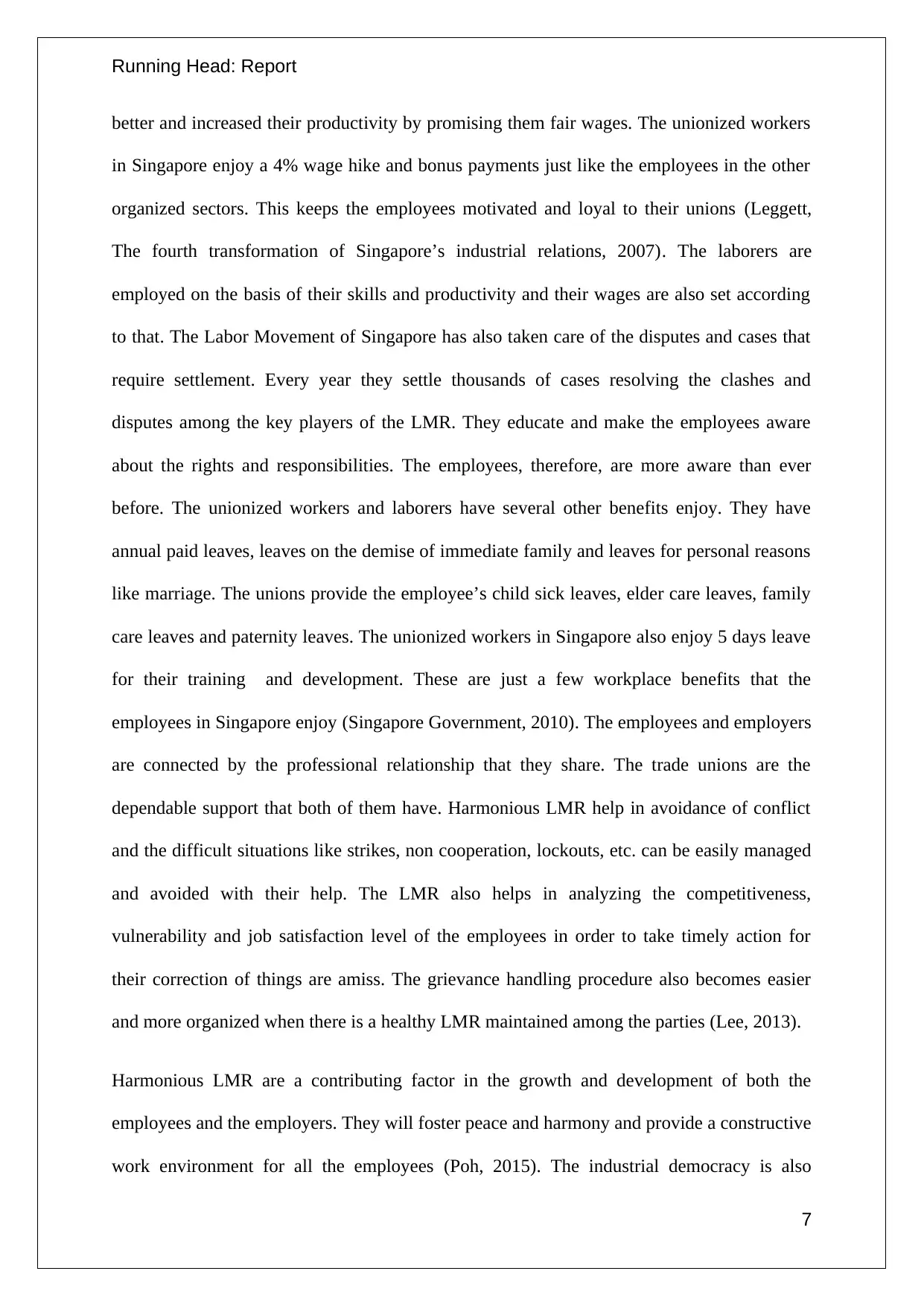
Running Head: Report
better and increased their productivity by promising them fair wages. The unionized workers
in Singapore enjoy a 4% wage hike and bonus payments just like the employees in the other
organized sectors. This keeps the employees motivated and loyal to their unions (Leggett,
The fourth transformation of Singapore’s industrial relations, 2007). The laborers are
employed on the basis of their skills and productivity and their wages are also set according
to that. The Labor Movement of Singapore has also taken care of the disputes and cases that
require settlement. Every year they settle thousands of cases resolving the clashes and
disputes among the key players of the LMR. They educate and make the employees aware
about the rights and responsibilities. The employees, therefore, are more aware than ever
before. The unionized workers and laborers have several other benefits enjoy. They have
annual paid leaves, leaves on the demise of immediate family and leaves for personal reasons
like marriage. The unions provide the employee’s child sick leaves, elder care leaves, family
care leaves and paternity leaves. The unionized workers in Singapore also enjoy 5 days leave
for their training and development. These are just a few workplace benefits that the
employees in Singapore enjoy (Singapore Government, 2010). The employees and employers
are connected by the professional relationship that they share. The trade unions are the
dependable support that both of them have. Harmonious LMR help in avoidance of conflict
and the difficult situations like strikes, non cooperation, lockouts, etc. can be easily managed
and avoided with their help. The LMR also helps in analyzing the competitiveness,
vulnerability and job satisfaction level of the employees in order to take timely action for
their correction of things are amiss. The grievance handling procedure also becomes easier
and more organized when there is a healthy LMR maintained among the parties (Lee, 2013).
Harmonious LMR are a contributing factor in the growth and development of both the
employees and the employers. They will foster peace and harmony and provide a constructive
work environment for all the employees (Poh, 2015). The industrial democracy is also
7
better and increased their productivity by promising them fair wages. The unionized workers
in Singapore enjoy a 4% wage hike and bonus payments just like the employees in the other
organized sectors. This keeps the employees motivated and loyal to their unions (Leggett,
The fourth transformation of Singapore’s industrial relations, 2007). The laborers are
employed on the basis of their skills and productivity and their wages are also set according
to that. The Labor Movement of Singapore has also taken care of the disputes and cases that
require settlement. Every year they settle thousands of cases resolving the clashes and
disputes among the key players of the LMR. They educate and make the employees aware
about the rights and responsibilities. The employees, therefore, are more aware than ever
before. The unionized workers and laborers have several other benefits enjoy. They have
annual paid leaves, leaves on the demise of immediate family and leaves for personal reasons
like marriage. The unions provide the employee’s child sick leaves, elder care leaves, family
care leaves and paternity leaves. The unionized workers in Singapore also enjoy 5 days leave
for their training and development. These are just a few workplace benefits that the
employees in Singapore enjoy (Singapore Government, 2010). The employees and employers
are connected by the professional relationship that they share. The trade unions are the
dependable support that both of them have. Harmonious LMR help in avoidance of conflict
and the difficult situations like strikes, non cooperation, lockouts, etc. can be easily managed
and avoided with their help. The LMR also helps in analyzing the competitiveness,
vulnerability and job satisfaction level of the employees in order to take timely action for
their correction of things are amiss. The grievance handling procedure also becomes easier
and more organized when there is a healthy LMR maintained among the parties (Lee, 2013).
Harmonious LMR are a contributing factor in the growth and development of both the
employees and the employers. They will foster peace and harmony and provide a constructive
work environment for all the employees (Poh, 2015). The industrial democracy is also
7
Paraphrase This Document
Need a fresh take? Get an instant paraphrase of this document with our AI Paraphraser

Running Head: Report
maintained in the system if all the key players are connected and have open discussions. It
benefits all the members as it increases the productivity of the firms and consequently the
nation. A competitive edge in the work environment can only help in getting the required
work from the employees. So, if the healthy work environment or the healthy competition is
required within the system, it is vital to provide employees with welfare schemes and
concord. The Labor Movement in Singapore is going strong even after 50 years of
independence. As a country with a skilled workforce and harmonious industrial relations,
Singapore enjoys a significant advantage. However, these relations need to be worked on
continuously by all the parties involved and strengthened to continue enjoying this advantage.
As the nation faces tough competition from the continuous technological advancement, it has
much to do to maintain strong labor-management relationship (SHRI, 2017). The
unionization of the employees which is generally avoided by other countries, as it leads to
stagnation of the economy and exploitation of the workforce, has instead proved to be
beneficial in practice, in Singapore. The strong collaboration between the parties involved in
LMR has led to increase in job-creation and a rise in the pay scale of the workers. The NTUC
in Singapore works constantly to ensure that the skills of the employees are constantly
upgraded and they get the pay and benefits from the employers as per their skills and
capability.
8
maintained in the system if all the key players are connected and have open discussions. It
benefits all the members as it increases the productivity of the firms and consequently the
nation. A competitive edge in the work environment can only help in getting the required
work from the employees. So, if the healthy work environment or the healthy competition is
required within the system, it is vital to provide employees with welfare schemes and
concord. The Labor Movement in Singapore is going strong even after 50 years of
independence. As a country with a skilled workforce and harmonious industrial relations,
Singapore enjoys a significant advantage. However, these relations need to be worked on
continuously by all the parties involved and strengthened to continue enjoying this advantage.
As the nation faces tough competition from the continuous technological advancement, it has
much to do to maintain strong labor-management relationship (SHRI, 2017). The
unionization of the employees which is generally avoided by other countries, as it leads to
stagnation of the economy and exploitation of the workforce, has instead proved to be
beneficial in practice, in Singapore. The strong collaboration between the parties involved in
LMR has led to increase in job-creation and a rise in the pay scale of the workers. The NTUC
in Singapore works constantly to ensure that the skills of the employees are constantly
upgraded and they get the pay and benefits from the employers as per their skills and
capability.
8

Running Head: Report
Conclusion
This report has been written with an intent to better understand and explain the LMR and the
various players that are responsible for the maintenance of the same for Singapore. The labor
relations in Singapore are a four cornered relationship between the government, the
employers, the labor unions and the laborers. The four parties involved need to coordinate
and cooperate with each other to maintain a healthy balance between them. The success of
Singapore and its growth and development can all be contributed to the healthy balance
between these three and a collaborative LMR in the nation. This report has explored and
conducted a factor analysis of what makes Singapore and their LMR an interesting and ideal
case study. The report further analyzed the competitive advantage that Singapore has as a
nation because of their exceptional LMR and a synchronized approach to relation of the four
key players of LMR. The Singapore government has realized that he key to a harmonious
workplace is increased collaboration between the employees, the employers and the unions
representing them. The increased competitiveness between the employees and the employers
is ultimately going to benefit the country as it will increase the productivity and efficiency of
the employees.
9
Conclusion
This report has been written with an intent to better understand and explain the LMR and the
various players that are responsible for the maintenance of the same for Singapore. The labor
relations in Singapore are a four cornered relationship between the government, the
employers, the labor unions and the laborers. The four parties involved need to coordinate
and cooperate with each other to maintain a healthy balance between them. The success of
Singapore and its growth and development can all be contributed to the healthy balance
between these three and a collaborative LMR in the nation. This report has explored and
conducted a factor analysis of what makes Singapore and their LMR an interesting and ideal
case study. The report further analyzed the competitive advantage that Singapore has as a
nation because of their exceptional LMR and a synchronized approach to relation of the four
key players of LMR. The Singapore government has realized that he key to a harmonious
workplace is increased collaboration between the employees, the employers and the unions
representing them. The increased competitiveness between the employees and the employers
is ultimately going to benefit the country as it will increase the productivity and efficiency of
the employees.
9
⊘ This is a preview!⊘
Do you want full access?
Subscribe today to unlock all pages.

Trusted by 1+ million students worldwide
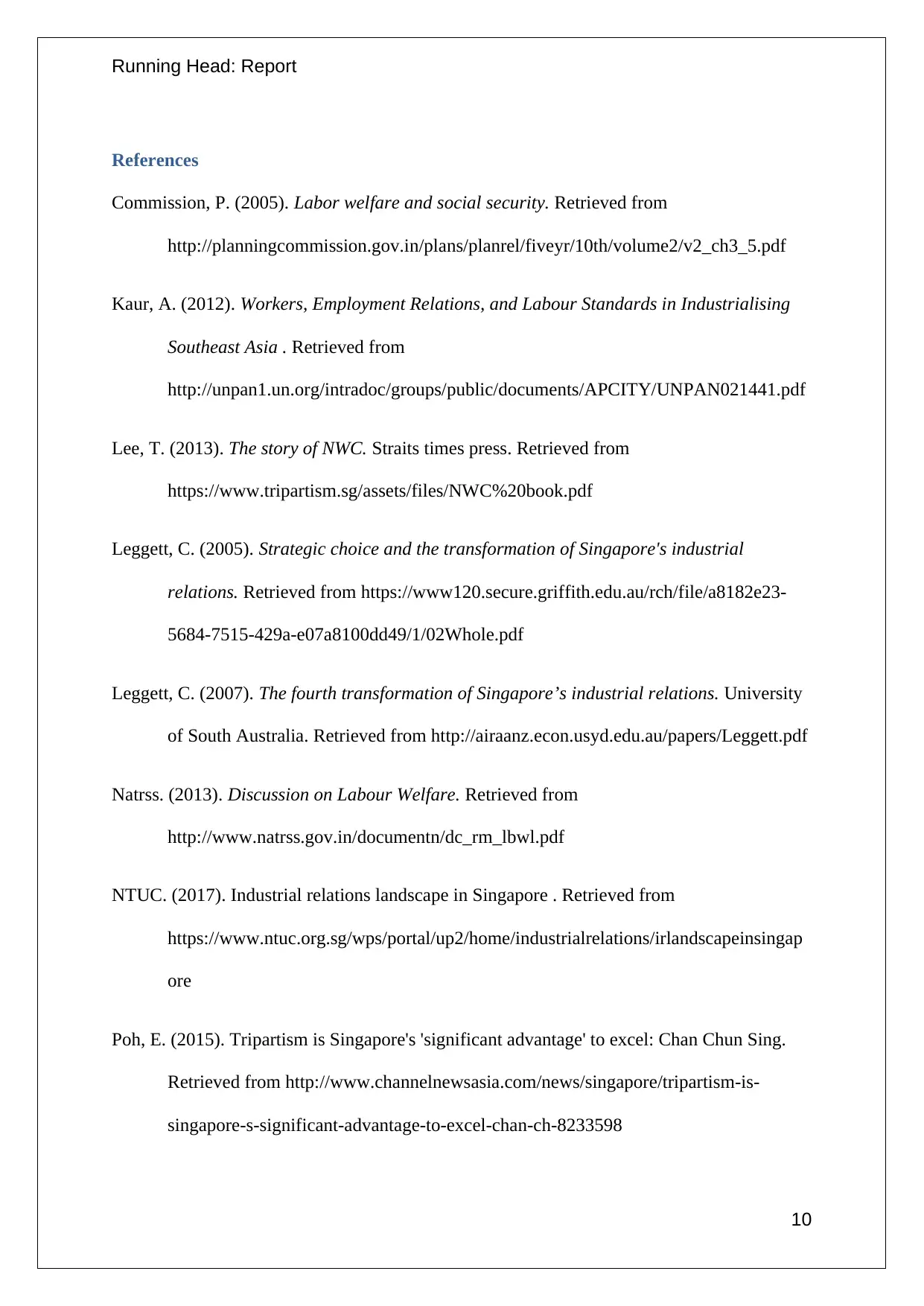
Running Head: Report
References
Commission, P. (2005). Labor welfare and social security. Retrieved from
http://planningcommission.gov.in/plans/planrel/fiveyr/10th/volume2/v2_ch3_5.pdf
Kaur, A. (2012). Workers, Employment Relations, and Labour Standards in Industrialising
Southeast Asia . Retrieved from
http://unpan1.un.org/intradoc/groups/public/documents/APCITY/UNPAN021441.pdf
Lee, T. (2013). The story of NWC. Straits times press. Retrieved from
https://www.tripartism.sg/assets/files/NWC%20book.pdf
Leggett, C. (2005). Strategic choice and the transformation of Singapore's industrial
relations. Retrieved from https://www120.secure.griffith.edu.au/rch/file/a8182e23-
5684-7515-429a-e07a8100dd49/1/02Whole.pdf
Leggett, C. (2007). The fourth transformation of Singapore’s industrial relations. University
of South Australia. Retrieved from http://airaanz.econ.usyd.edu.au/papers/Leggett.pdf
Natrss. (2013). Discussion on Labour Welfare. Retrieved from
http://www.natrss.gov.in/documentn/dc_rm_lbwl.pdf
NTUC. (2017). Industrial relations landscape in Singapore . Retrieved from
https://www.ntuc.org.sg/wps/portal/up2/home/industrialrelations/irlandscapeinsingap
ore
Poh, E. (2015). Tripartism is Singapore's 'significant advantage' to excel: Chan Chun Sing.
Retrieved from http://www.channelnewsasia.com/news/singapore/tripartism-is-
singapore-s-significant-advantage-to-excel-chan-ch-8233598
10
References
Commission, P. (2005). Labor welfare and social security. Retrieved from
http://planningcommission.gov.in/plans/planrel/fiveyr/10th/volume2/v2_ch3_5.pdf
Kaur, A. (2012). Workers, Employment Relations, and Labour Standards in Industrialising
Southeast Asia . Retrieved from
http://unpan1.un.org/intradoc/groups/public/documents/APCITY/UNPAN021441.pdf
Lee, T. (2013). The story of NWC. Straits times press. Retrieved from
https://www.tripartism.sg/assets/files/NWC%20book.pdf
Leggett, C. (2005). Strategic choice and the transformation of Singapore's industrial
relations. Retrieved from https://www120.secure.griffith.edu.au/rch/file/a8182e23-
5684-7515-429a-e07a8100dd49/1/02Whole.pdf
Leggett, C. (2007). The fourth transformation of Singapore’s industrial relations. University
of South Australia. Retrieved from http://airaanz.econ.usyd.edu.au/papers/Leggett.pdf
Natrss. (2013). Discussion on Labour Welfare. Retrieved from
http://www.natrss.gov.in/documentn/dc_rm_lbwl.pdf
NTUC. (2017). Industrial relations landscape in Singapore . Retrieved from
https://www.ntuc.org.sg/wps/portal/up2/home/industrialrelations/irlandscapeinsingap
ore
Poh, E. (2015). Tripartism is Singapore's 'significant advantage' to excel: Chan Chun Sing.
Retrieved from http://www.channelnewsasia.com/news/singapore/tripartism-is-
singapore-s-significant-advantage-to-excel-chan-ch-8233598
10
Paraphrase This Document
Need a fresh take? Get an instant paraphrase of this document with our AI Paraphraser

Running Head: Report
SHRI. (2017). Going the Tripartite Way – A Showcase of Singapore’s Unique Business
Model. Retrieved from http://shri.org.sg/going-the-tripartite-way-a-showcase-of-
singapores-unique-business-model/
Singapore Government. (2010). Industrial relations act. Retrieved from
http://www.aseanhrmech.org/downloads/singapore-Industrial_Relations_Act.pdf
Yoon, Y. (2009). A comparative study on industrial relations and collective bargaining in
East Asian countries. Retrieved from http://natlex.ilo.ch/wcmsp5/groups/public/---
ed_dialogue/---dialogue/documents/publication/wcms_158351.pdf
11
SHRI. (2017). Going the Tripartite Way – A Showcase of Singapore’s Unique Business
Model. Retrieved from http://shri.org.sg/going-the-tripartite-way-a-showcase-of-
singapores-unique-business-model/
Singapore Government. (2010). Industrial relations act. Retrieved from
http://www.aseanhrmech.org/downloads/singapore-Industrial_Relations_Act.pdf
Yoon, Y. (2009). A comparative study on industrial relations and collective bargaining in
East Asian countries. Retrieved from http://natlex.ilo.ch/wcmsp5/groups/public/---
ed_dialogue/---dialogue/documents/publication/wcms_158351.pdf
11
1 out of 11
Related Documents
Your All-in-One AI-Powered Toolkit for Academic Success.
+13062052269
info@desklib.com
Available 24*7 on WhatsApp / Email
![[object Object]](/_next/static/media/star-bottom.7253800d.svg)
Unlock your academic potential
Copyright © 2020–2025 A2Z Services. All Rights Reserved. Developed and managed by ZUCOL.





